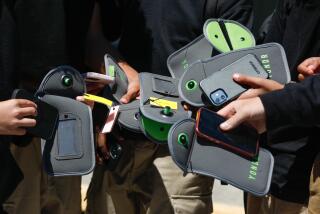School in Irvine halts its plan to scan fingerprints
- Share via
A plan to scan the fingerprints of 2,200 Irvine high school students to ease lunch lines was scrapped this week after angry parents argued it would violate teens’ privacy rights.
A spokesman for the Irvine Unified School District said district administrators had been unaware of University High School’s proposal and had halted its implementation.
“This is not something we will be using at our schools,” said Ian Hanigan, district spokesman. “It’s safe to say that this pilot [program] was marched out probably a little too quickly, without the study and evaluation needed to do something like this.”
Students currently use a numeric code linked to a prepaid account to buy their lunch or snacks. But theft of the codes, coupled with a desire to reduce students’ time spent in line, prompted Principal John Pehrson to consider fingerprint scanning.
“We wanted to speed up the process and make the theft [aspect] minimal,” he said. “This was an idea that is already being used in other parts of the country.”
Such technology is used primarily at schools on the East Coast and in the South, as well as in Europe. A quarter of the school districts in West Virginia use fingerprint scans to identify students, according to Anne Marie Dunphy, chief financial officer of Malvern, Penn.-based identiMetrics, which created the technology and has placed it in more than 400 schools across the nation.
Dunphy said scanning teens’ fingertips was far more secure than having students carry identification cards with their picture, name and school location that can easily be lost.
University High School had planned to start scanning students’ fingerprints Monday. Students’ index fingers would be mapped by a biometric scanner, which would create a grid of the unique lines, curls and swishes. These points would be converted into a series of numbers, which would be used to identify students when they bought their lunches.
No fingerprint pictures are saved, said Jay Fry, president of identiMetrics. “You can’t re-create a fingerprint image from the information that is stored,” he said. He also said that educators needed to inform students, teachers and community members about how the technology works.
“It certainly is a matter of educating the public,” Fry said.
Dunphy added: “It’s very simple to install, and it’s very easy to use. People get weirded out.”
Indeed, local parents and civil libertarians are skeptical.
Ted Faison, the father of a University High senior, said he learned about the proposal when he received a letter Friday informing him that the scanning was to begin Monday.
“It’s a violation of their privacy,” he said. “They collect enough information to identify a person’s fingerprint, and could easily share this with law enforcement or anyone else. Students would have no control over where the information could be used.”
Hector Villagra, director of the Orange County chapter of the American Civil Liberties Union, agreed.
“Parents are rightly concerned about the privacy of their children,” he said. “These fingerprint scanners look like overkill. You can do the same identification of students without this type of technology and without the danger of creating a database that could be used for other purposes or that could be breached.”
Junior Emerald Greene described the proposal as “creepy.”
“It is an invasion of privacy because they are monitoring what food I buy and how much money I spend,” the 17-year-old said.
*
Times correspondent Paul Gackle contributed to this report.
*
(BEGIN TEXT OF INFOBOX)
Fingerprint payment
A fingerprint payment system University High School students were to use to pay for cafeteria food was scrapped by Irvine Unified School District.
1. A student using the fingerprint payment system would have his or her finger scanned in advance.
2. Computer software would create a grid of intersection points from the scanned finger’s swirls and arcs.
3. The software would then create a template showing the intersection of unique points on the finger.
4 The software would store a set of numbers that could be interpreted only as a template. A fingerprint image would not be stored.
5. When the student returned to buy food, his or her finger would be scanned again, forming another fingerprint template, which would be matched to the stored template.
---
Source: identiMetrics Inc. Graphics reporting by Seema Mehta
More to Read
Sign up for Essential California
The most important California stories and recommendations in your inbox every morning.
You may occasionally receive promotional content from the Los Angeles Times.











